
Home | Card Index | | | |
 Home | Card Index | | | | |
Eman Robitschek to Grete Kann - April 23, 1916Transcription and translation by Werner Sepper. |
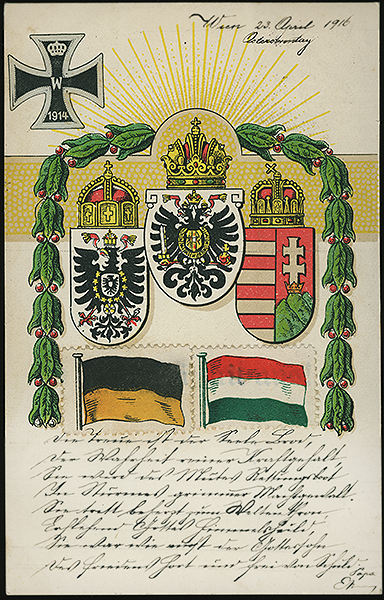 |
Die Treue ist der Seele Brod Fidelity is bread for the soul Notes: |

|
 |
| This began as a stock patriotic postcard showing the crowns and crests to Germany, Austria and Hungary. To this Eman added three labels: the Iron Cross and two flags. On the surface, the card looks as though it provides patriotic support for the German war effort. But the poem is about the personification of Fidelity, and as in many of Eman's cards, the image on the front of the card also speaks to the message on the reverse. |

|
 |

Although the three crests printed on the card might reference the Germanic alliance in WWI or the Germanic world broadly, in reality Eman primarily is pointing us to the Germanic royal lines. The first hint of this is that Turkey, the fourth major participant in the war on the German side, is not signified at all. Then there is the curious case of the black and gold flag. When it is flown with the gold on top, it is a military battle flag of Austria, but when, as depicted here, it is flown with the black on top, it is the personal household flag of the royal family, used in events and over buildings to signify the presence of the Emperor and his family. The Hungarian flag is used both ways. Hence, Eman is telling us that this card is primarily about royal lines and succession. It is the Iron Cross that links the contents of the card to the war. 218,000 were awarded to German, Austrian and Hungarian troops for their contributions on the field of battle. Eman's message is that the Germanic peoples were true and loyal to their leaders even as those leaders failed their sacred trust. The poem is telling us that the Fidelity of the German peoples stood before God when their anointed leaders abdicated the World-Throne. Learn more about the history of the Iron Cross. |

|
 |
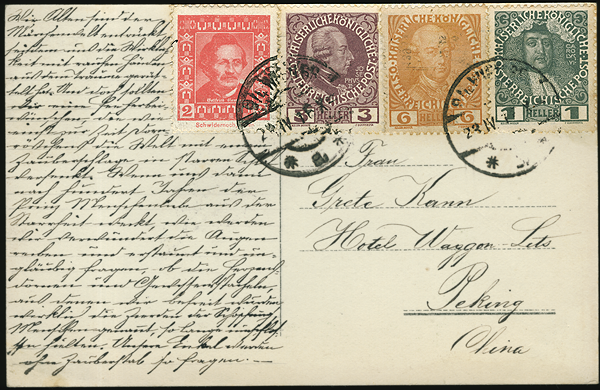 |
||
|
Wir Alten sind dem |
Us old ones are snatched away |
|

|
 |
| Eman Robitschek was born in the early 1850s, so "us old ones" and the essay that follows might reasonably be taken to mean people in his generation. Taken this way, it is a lament commonly expressed by older people when they look back over their lives and times: we have squandered our lives and ruined much that is desirable in our world - what will our grandchildren think of us? |

|
 |

But Eman is never that straight forward. There are three postage stamps and a label which accompany this little essay and radically alter the interpretive context. Eman wrote this card for his daughter, who lived in China in 1916. The postage to China was 10 Heller and Eman used the 1, 3 and 6 Heller definitive postage stamps to make up the postage. These are past Emperors of Austria and the Holy Roman Empire: Karl VI (1711-1740), Joseph II (1780-1790), and Leopold II (1790-1792). They are the "old ones" who are ostensibly the subjects of Eman's essay. The message, like the fairytale, is "Grimm": You "old ones" chose to live in a fairytale while you occupied the world throne, you failed the German people and the world, and now the world of your grandchildren is calling you to account in a bloody war. In this context, the Iron Cross on the front of the card represents the multitude of faithful soldiers who have died because of the failure of the "old ones". |
|
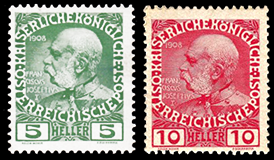
|
But if we look deeper, we find that Eman's real target is Franz Joseph, Emperor from 1848 to 1916. Normally, to make up a 10 Heller postage rate, you would use a 10 Heller stamp or two 5 Heller stamps; both stamps honor Franz Joseph. Eman doesn't use these stamps on this card because he does not want to be caught criticizing the monarchy directly, a serious offense, especially during a time of war. |

|
 |
|
HOW DO WE KNOW ABOUT THIS ?
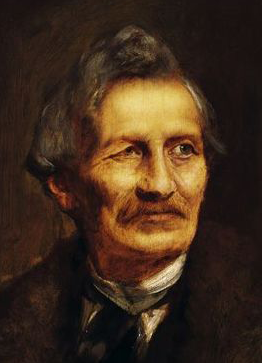
|
We know because of the rose colored label, the same color as the 10 Heller stamp of Franz Joseph, that is placed to the left of the "imperial" postage stamps. This label depicts the renowned architect Gottfried Semper (1803 - 1879) and was copied from the painting that Franz von Lenbach made in 1879 shortly before Semper's death. Semper's inclusion in the context of this card is highly provocative and tells us much of how Eman Robitschek thought about the world.
|
|
In 1834, after lengthy training and research, and some success as a scholar, Semper became Professor of Architecture at the Royal Academy for Building Arts in Dresden. Semper was Jewish and his first architectural masterstroke was to design the Dresden Synagogue, later called the Semper Synagogue, and one of the most prominent in Europe. It was burned to the ground in Kristallnacht in 1938, but is preserved in this steel plate engraving by Louis Thümling, dating from ca. 1860. Use the link for history & interior shots. |
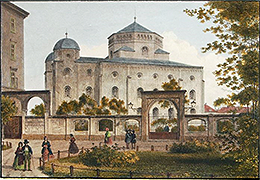 |
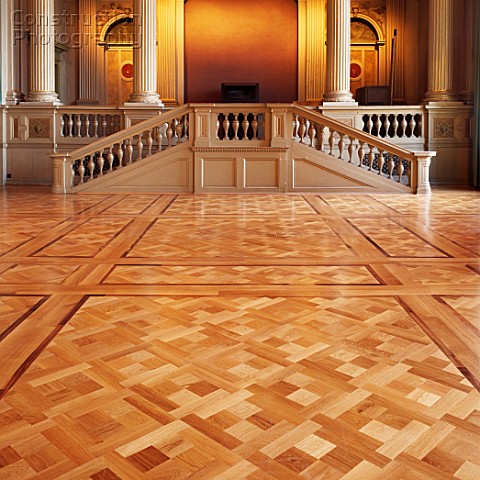
|
Semper participated in the 1849 "Dresden Spring" uprising, which was ruthlessly put down. In consequence, he fled briefly to Switzerland and then onward to England, where he found little work professionally but managed to write the three books on architecture that would make him world famous. This enabled him to return to Switzerland, where he designed a complex that included the Swiss Federal Technical Institute (interior entry to the left) and the University of Zurich, a major architectural achievement that once again moved him into the forefront of European architects. In 1863, an amnesty was declared for those who participated in the 1849 uprising and Semper was promptly employed, first by Bavaria's King Ludwig II, and soon thereafter by Emperor Franz Joseph. |
|
Soon after becoming Emperor, Franz Joseph undertook the urban renewal of the capital in central Vienna. The idea was to replace the ancient ramparts and free-fire zone around the inner city with a set of integrated thoroughfares, open spaces, monuments and monumental buildings on the scale of Rome at its height. By 1860, the general plan was complete. It was called the Ringstraßa after a series of interlocking boulevards that would ring the center of Vienna, defining the public space at the heart of the capital. |
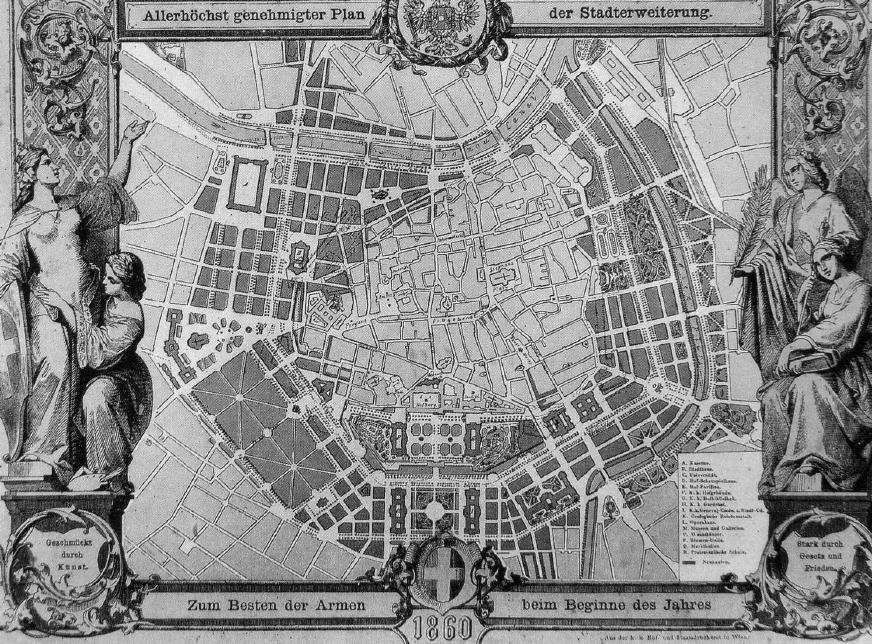 |
| Franz Joseph wanted the best architect in Germanic Europe who could work on a monumental scale. Eventually, he sent for Gottfried Semper, and Gottfried Semper answered the call. Semper got right to the heart of the business, designing an Imperial Forum in 1869 and moving his family to Vienna in 1871. | |
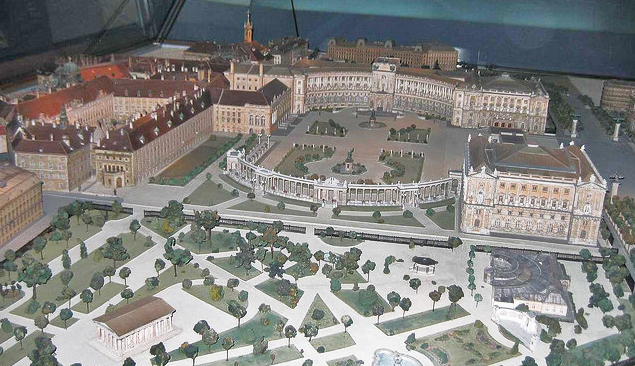
|
Semper designed an extension to the Imperial Place, the Hofburg, completed in 1881, that was designed to be the formal entrance to the Heldenplatz, the Plaza of Heros. He was also the designer or principal architect for a number of other buildings along the Ringstraßa, but as construction went forward, disagreements with others working on the project led Semper to resign in 1876. |
|
The Imperial Forum and most of the other components of the Ringstraßa were never built as Franz Joseph grew older and the Empire became less and less vital. But three of the buildings for which Semper was principal architect were completed after his death. These are the City Theater (lower most dome far left), the Museum of Art History, and the Museum of Natural History (towered rectangle at the lower right), which anchors one side of the Heldenplatz. |
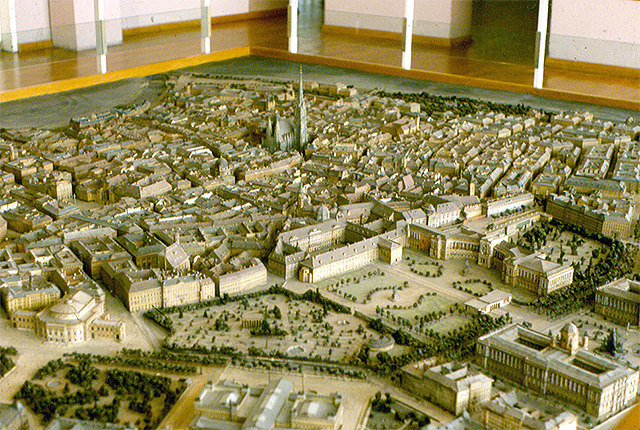
|
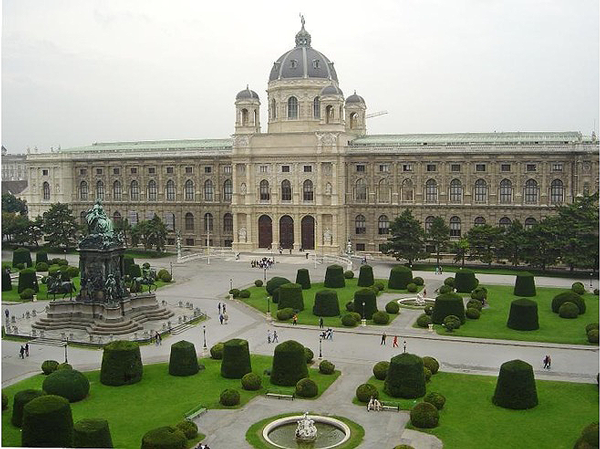
|
These museums are enormous. Today, the Museum of Natural History contains a number of huge dinosaur galleries and is full of elegantly designed architectural spaces. In the photo on the left, the smudge at the bottom of the steps leading up to the main entrance of the museum is a tour group being prepared by its guide. The front doors are about four stories high. |
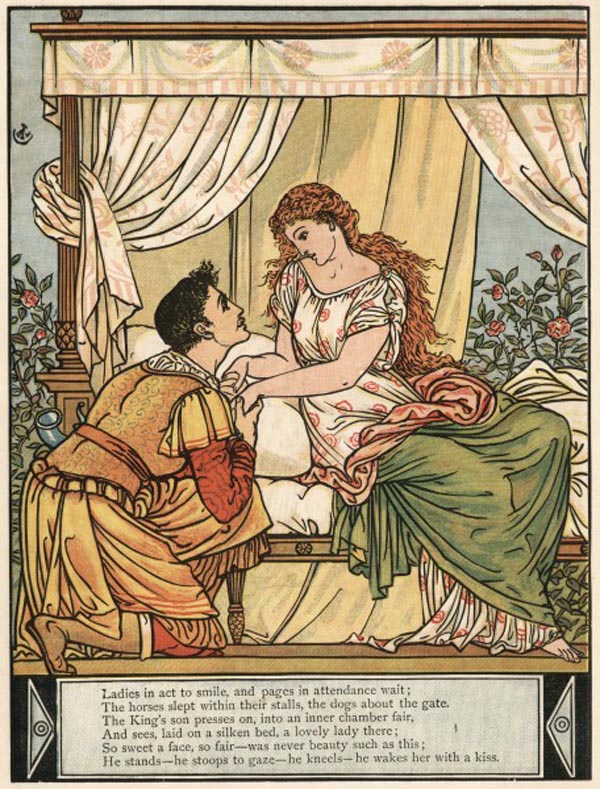
|
It begins with the revolts of 1848/49. The "thorn" is the brutal repression of these revolts, which puts the entire empire into an enchanted sleep. Franz Joseph, the dreamer, spins dream castles within his enchanted realm while the world without changes. The Great War is the assault on the englobing enchantment. Little Thornrose, and with her all the empire, is about to be awakened. But to what, and who will have to pick up the pieces? Eman foresees that it will be the grandchildren of the empire - his grandchildren. |
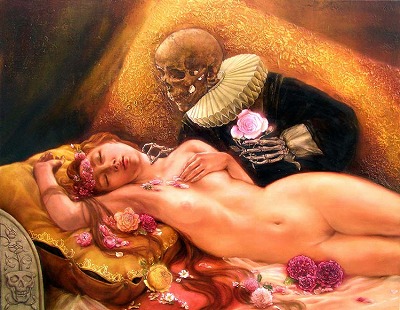 Thornrose by Toko Yuma |
| Eman Robitschek was correct in his analysis, but he did not foresee the terrible price his grandchildren's generation would have pay for the failing of their great grand-elders. | ||

|
 |
|
©2013-2014 by Charles M. Nelson All rights reserved. |